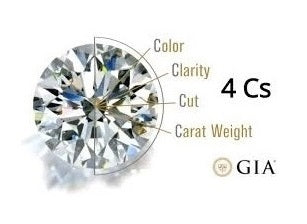
Using Our Loose Diamond Search

When it comes to looking for just the right diamond, it seems that the more you learn the more you feel you might still need to know!
On the one hand are the gemologists who have built up considerable knowledge of all things pertaining to precious gemstones. On the other is the customer who, quite understandibly, has limited experience and understanding of what they should be looking for.
This presents a challenge for reputable jewellers: provide customers with as much information as possible to help them make an informed decision- but avoid making the process confusing and laborious.

To draw a parallel with buying a new car, few of us are experts and it is not something we do on a regular basis. Nevertheless, it represents a substantial financial commitment and we need to live with our decision for some time to come.
Most importantly too, we tend to buy something that appeals to us. Something that talks to our hearts, not just our heads.
By taking a top down approach, this whole process becomes less daunting. Sure, it does require a little focus and attention but it is well worth it.
When you appreciate that an almost flawless one carat diamond can be worth three times or more than a much lower grade stone of similar weight, some rudamentary knowledge can really help you in making the right call. And help you avoid paying too much for something you don't really want.
Most of us will have heard of the "4 C's". You can see more about the "4 C's" here, but let's highlight a few key points in summary:
Cut This is not to be confused with the shape. The cut refers to the myriad of intricate angles and shapes cut in to the diamond. This directly informs the general level of sparkle and liveliness of the stone, whatever the colour and clarity. We advise opting for Excellent or Very Good.
Colour More important than clarity, colour is graded in order of merit from D (the "whitest") through to Z (the most "yellow"). D,E and F are considered the top colour group. G and H are near colourless. Colour F is extremely difficult to distinguish from D or E and typically priced a tad lower. As a rule of thumb we suggest going for a colour grade of H or higher On the subject of colour it is also important to consider fluorescence, milkiness and shading. These factors will also have an impact on how clean and white the diamond looks.

Clarity The clearer the diamond the better. Flawless diamonds ("FL") are rare and therefore more valuable. In the case of larger carat weight stones, clarity has a significant influence on price. But tiny inclusions and fissures can be extremely difficult to see with the naked eye. In fact, a diamond which is considered "eyeclean" (meaning that any such marks cannot be seen without magnification) is going to represent much better value for money. It is possible to find a seemingly clear diamond with a grade of "Si1" (Slightly Included). Just reach out to us if you would like further guidance.
Carat Weight Essentially, the correct term for the size of any given diamond. This is the easiest of the 4 C's to establish and unsurprisingly has a direct influence on value, albeit in the context of the other "C's" considered above. It is worth noting that the surface (or "face up") area does not increase by anywhere near the same proportion as a corresponding increase in it's weight. See recent blog
LAUNCH DIAMOND SEARCH

- Select Natural Diamonds (default) or Lab Grown Diamonds by selecting tab in header.
- For coloured diamonds such as pinks and blues, select the tab marked fancy, which you will find to the centre right of the screen.
- Select desired diamond shape from the icons
- Use the slider or - if easier - key in the minimum and maximum carat weight
- Select the colour range, with D being the whitest
- Select cut - we recommend Very Good or Excellent
- Stipulate a price range or leave blank (default)
- More Filters. We suggest selecting Good polish or above
- For Table please refer to our guide on diamond anatomy
- Fluorescence - we suggest opting for None to Medium
- For most diamond shapes Good symmetry and above is advisable. In the case of oval, pear and marquise cut the symmetry is more crucial and should ideally be Very Good or Excellent
- For Depth please refer to diamond anatomy
- Lab refers to the gemological institute which has graded and certified the specific diamond See certification

Once you click on a specific diamond a more detaild product page will open. You are then able to add to cart and proceed to checkout or continue shopping.
If there is more information you require about any individual diamond please reach out to us. If the specific diamond you select does not include a video or image we can usually send these to you.

+44 (0) 20 3998 3075



